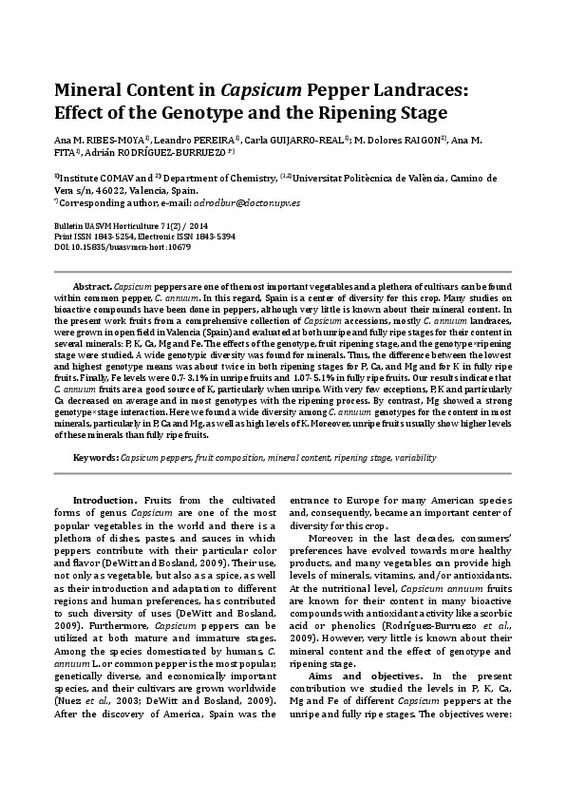JavaScript is disabled for your browser. Some features of this site may not work without it.
Buscar en RiuNet
Listar
Mi cuenta
Estadísticas
Ayuda RiuNet
Admin. UPV
Mineral Content in Capsicum Pepper Landraces: Effect of the Genotype and the Ripening Stage
Mostrar el registro sencillo del ítem
Ficheros en el ítem
| dc.contributor.author | Ribes Moya, Ana María
|
es_ES |
| dc.contributor.author | Pereira, L.
|
es_ES |
| dc.contributor.author | Guijarro Real, Carla
|
es_ES |
| dc.contributor.author | Raigón Jiménez, Mª Dolores
|
es_ES |
| dc.contributor.author | Fita, Ana
|
es_ES |
| dc.contributor.author | Rodríguez Burruezo, Adrián
|
es_ES |
| dc.date.accessioned | 2016-04-25T09:43:49Z | |
| dc.date.available | 2016-04-25T09:43:49Z | |
| dc.date.issued | 2014 | |
| dc.identifier.issn | 1843-5254 | |
| dc.identifier.uri | http://hdl.handle.net/10251/62878 | |
| dc.description.abstract | [EN] Capsicum peppers are one of the most important vegetables and a plethora of cultivars can be found within common pepper, C. annuum. In this regard, Spain is a center of diversity for this crop. Many studies on bioactive compounds have been done in peppers, although very little is known about their mineral content. In the present work fruits from a comprehensive collection of Capsicum accessions, mostly C. annuum landraces, were grown in open field in Valencia (Spain) and evaluated at both unripe and fully ripe stages for their content in several minerals: P, K, Ca, Mg and Fe. The effects of the genotype, fruit ripening stage, and the genotype×ripening stage were studied. A wide genotypic diversity was found for minerals. Thus, the difference between the lowest and highest genotype means was about twice in both ripening stages for P, Ca, and Mg and for K in fully ripe fruits. Finally, Fe levels were 0.7-3.1% in unripe fruits and 1.07-5.1% in fully ripe fruits. Our results indicate that C. annuum fruits are a good source of K, particularly when unripe. With very few exceptions, P, K and particularly Ca decreased on average and in most genotypes with the ripening process. By contrast, Mg showed a strong genotype×stage interaction. Here we found a wide diversity among C. annuum genotypes for the content in most minerals, particularly in P, Ca and Mg, as well as high levels of K. Moreover, unripe fruits usually show higher levels of these minerals than fully ripe fruits. | es_ES |
| dc.description.sponsorship | work financed by INIA (RTA2010-00038-C03-03), FEDER funds. | |
| dc.language | Inglés | es_ES |
| dc.publisher | University of Agricultural Sciences and Veterinary Medicine Cluj-Napoca | es_ES |
| dc.relation.ispartof | Bulletin of University of Agricultural Sciences and Veterinary Medicine Cluj-Napoca : Horticulture | es_ES |
| dc.rights | Reserva de todos los derechos | es_ES |
| dc.subject | Capsicum peppers | es_ES |
| dc.subject | Fruit composition | es_ES |
| dc.subject | Mineral content | es_ES |
| dc.subject | Ripening Stage | es_ES |
| dc.subject | Variability | es_ES |
| dc.subject.classification | GENETICA | es_ES |
| dc.subject.classification | QUIMICA ANALITICA | es_ES |
| dc.subject.classification | EDAFOLOGIA Y QUIMICA AGRICOLA | es_ES |
| dc.title | Mineral Content in Capsicum Pepper Landraces: Effect of the Genotype and the Ripening Stage | es_ES |
| dc.type | Artículo | es_ES |
| dc.identifier.doi | 10.15835/buasvmcn-hort:10679 | |
| dc.relation.projectID | info:eu-repo/grantAgreement/MICINN//RTA2010-00038-C03-03/ES/RTA2010-00038-C03-03/ | es_ES |
| dc.rights.accessRights | Abierto | es_ES |
| dc.contributor.affiliation | Universitat Politècnica de València. Instituto Universitario de Conservación y Mejora de la Agrodiversidad Valenciana - Institut Universitari de Conservació i Millora de l'Agrodiversitat Valenciana | es_ES |
| dc.contributor.affiliation | Universitat Politècnica de València. Departamento de Química - Departament de Química | es_ES |
| dc.contributor.affiliation | Universitat Politècnica de València. Departamento de Biotecnología - Departament de Biotecnologia | es_ES |
| dc.description.bibliographicCitation | Ribes Moya, AM.; Pereira, L.; Guijarro Real, C.; Raigón Jiménez, MD.; Fita, A.; Rodríguez Burruezo, A. (2014). Mineral Content in Capsicum Pepper Landraces: Effect of the Genotype and the Ripening Stage. Bulletin of University of Agricultural Sciences and Veterinary Medicine Cluj-Napoca : Horticulture. 71(2):359-360. https://doi.org/10.15835/buasvmcn-hort:10679 | es_ES |
| dc.description.accrualMethod | S | es_ES |
| dc.relation.publisherversion | http://dx.doi.org/10.15835/buasvmcn-hort:10679 | es_ES |
| dc.description.upvformatpinicio | 359 | es_ES |
| dc.description.upvformatpfin | 360 | es_ES |
| dc.type.version | info:eu-repo/semantics/publishedVersion | es_ES |
| dc.description.volume | 71 | es_ES |
| dc.description.issue | 2 | es_ES |
| dc.relation.senia | 278010 | es_ES |
| dc.contributor.funder | Instituto Nacional de Investigación y Tecnología Agraria y Alimentaria |








